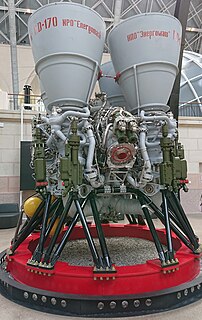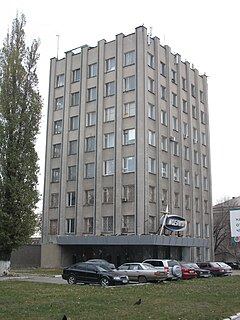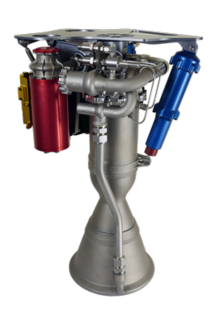Related Research Articles

A liquid-propellant rocket or liquid rocket utilizes a rocket engine that uses liquid propellants. Liquids are desirable because they have a reasonably high density and high specific impulse (Isp). This allows the volume of the propellant tanks to be relatively low. It is also possible to use lightweight centrifugal turbopumps to pump the rocket propellant from the tanks into the combustion chamber, which means that the propellants can be kept under low pressure. This permits the use of low-mass propellant tanks that do not need to resist the high pressures needed to store significant amounts of gasses, resulting in a low mass ratio for the rocket.

The staged combustion cycle is a power cycle of a bipropellant rocket engine. In the staged combustion cycle, propellant flows through multiple combustion chambers, and is thus combusted in stages. The main advantage relative to other rocket engine power cycles is high fuel efficiency, measured through specific impulse, while its main disadvantage is engineering complexity.

The RD-170 is the world's most powerful and heaviest liquid-fuel rocket engine. It was designed and produced in the Soviet Union by NPO Energomash for use with the Energia launch vehicle. The engine burns kerosene fuel and LOX oxidizer in four combustion chambers, all supplied by one single-shaft, single-turbine turbopump rated at 170 MW (230,000 hp) in a staged combustion cycle.

Long March 5, or Changzheng 5 (CZ-5), and also by its nickname "Pang-Wu", is a Chinese heavy-lift launch vehicle developed by the China Academy of Launch Vehicle Technology (CALT). It is the first Chinese launch vehicle designed to use exclusively non-hypergolic liquid propellants. It is the fifth iteration of the Long March rocket family.
The YF-75 is a liquid cryogenic rocket engine burning liquid hydrogen and liquid oxygen in a gas generator cycle. It is China's second generation of cryogenic propellant engine, after the YF-73, which it replaced. It is used in a dual engine mount in the H-18 third stage of the Long March 3A, Long March 3B and Long March 3C launch vehicles. Within the mount, each engine can gimbal individually to enable thrust vectoring control. The engine also heats hydrogen and helium to pressurize the stage tanks and can control the mixture ratio to optimize propellant consumption.
The YF-77 is China's first cryogenic rocket engine developed for booster applications. It burns liquid hydrogen fuel and liquid oxygen oxidizer using a gas generator cycle. A pair of these engines powers the LM-5 core stage. Each engine can independently gimbal in two planes. Although the YF-77 is ignited prior to liftoff, the LM-5's four strap-on boosters provide most of the initial thrust in an arrangement similar to the European Vulcain on the Ariane 5 or the Japanese LE-7 on the H-II.

The YF-100 is a Chinese liquid rocket engine burning LOX and kerosene in an oxidizer-rich staged combustion cycle.

Chemical Automatics Design Bureau (CADB), also KB Khimavtomatika, is a Russian design bureau founded by the NKAP in 1941 and led by Semyon Kosberg until his death in 1965. Its origin dates back to a 1940 Moscow carburetor factory, evacuated to Berdsk in 1941, and then relocated to Voronezh city in 1945, where it now operates. Originally designated OKB-296 and tasked to develop fuel equipment for aviation engines, it was redesignated OKB-154 in 1946.
The Long March 7, or Chang Zheng 7 in pinyin, abbreviated LM-7 for export or CZ-7 within China, originally Long March 2F/H or Chang Zheng 2F/H, nicknamed Bingjian, is a Chinese liquid-fuelled launch vehicle of the Long March family, developed by the China Aerospace Science and Technology Corporation (CAST). It made its inaugural flight on 25 June 2016.
The RD-120 is a liquid upper stage rocket engine burning RG-1 and LOX in an oxidizer rich staged combustion cycle with an O/F ratio of 2.6. It is used in the second stage of the Zenit family of launch vehicles. It has a single, fixed combustion chamber and thus on the Zenit it is paired with the RD-8 vernier engine. The engine has been developed from 1976 to 1985 by NPO Energomash with V.P. Radovsky leading the development. It is manufactured by, among others, Yuzhmash in Ukraine.

Since the founding of SpaceX in 2002, the company has developed four families of rocket engines — Merlin, Kestrel, Draco and SuperDraco — and is currently developing another rocket engine: Raptor, and after 2020, a new line of methox thrusters.
Long March 9 is a Chinese super-heavy carrier rocket concept that is currently under development. It is the ninth iteration of the Long March rocket family, named for the Chinese Red Army's 1934–35 Long March campaign during the Chinese Civil War.
The SCE-200 is an Indian, under-development, liquid-fuel rocket engine, burning liquid oxygen (LOX) and RP-1 kerosene in an oxidizer-rich staged combustion cycle. This engine is expected to power Indian Space Research Organization's upcoming Unified Launch Vehicle (ULV) and Reusable Launch Vehicle (RLV). It is being developed by the Liquid Propulsion Systems Centre, a subsidiary of ISRO. But before that it will be tested on a GSLV Mk III by replacing the L110 stage powered by the Vikas engine with an SC-200 stage powered by SCE-200 engine and a 200 tonne propellant load.
The YF-115 is a Chinese liquid rocket engine burning LOX and kerosene in an oxidizer-rich staged combustion cycle. A high efficiency/high thrust environmental friendly rocket engine was always an objective within Programme 863. Development began in the 2000s, along with its sibling, the bigger YF-100, which would power the LM-5, LM-6 and LM-7 boosters and first stages. Testing was directed by the China National Space Administration (CNSA) commencing in 2005. Development works are mainly carried out by the Xi'an Aerospace Propulsion Institute. It will be used as upper stage engine for China's next generation of medium and light environmental-friendly launch vehicles, namely the Long March 6 and the Long March 7. During early 2012, the engine system successfully passed vacuum testing. It is China's first upper stage rocket engine to adopt the staged-combustion cycle.
The YF-75D is a liquid cryogenic rocket engine burning liquid hydrogen and liquid oxygen in a closed expander cycle. It is China's third generation of upper stage cryogenic propellant engine, after the YF-73 and the YF-75. It is used in a dual engine mount in the H5-2 second stage of the Long March 5 launch vehicles. Within the mount, each engine can gimbal individually to enable thrust vectoring control. As its predecessor, the YF-75 it can adjust its mixture ratio to optimize propellant consumption. But as an additional improvement, it can do multiple restarts, against the single one of its predecessor.
The RD-801 is a Ukrainian liquid propellant rocket engine burning LOX and Kerosene (RG-1) in a staged combustion cycle. It has a single combustion chamber that provides thrust vector control by gimbaling of the nozzle in two axis by +/- 6°. It is being designed in Ukraine by Yuzhnoye Design Bureau for the prospective first stage propulsion of the Mayak rocket family.

Rutherford is a liquid-propellant rocket engine designed by aerospace company Rocket Lab and manufactured in Long Beach, California. The engine is used on the company's own rocket, Electron. It uses LOX and RP-1 as its propellants and is the first flight-ready engine to use the electric-pump feed cycle. The rocket uses a similar engine arrangement to the Falcon 9; a two-stage rocket using a cluster of nine identical engines on the first stage, and one vacuum-optimized version with a longer nozzle on the second stage. This arrangement is also known as an octaweb. The sea-level version produces 24.9 kN (5,600 lbf) of thrust and has a specific impulse of 311 s (3.05 km/s), while the vacuum optimized-version produces 25.8 kN (5,800 lbf) of thrust and has a specific impulse of 343 s (3.36 km/s).

Raptor is a family of full-flow staged-combustion-cycle rocket engines developed and manufactured by SpaceX for use on the in-development SpaceX Starship. The engine is powered by cryogenic liquid methane and liquid oxygen ("methalox") rather than the RP-1 and liquid oxygen ("kerolox") used in SpaceX's prior Merlin and Kestrel rocket engines. The Raptor engine has more than twice the thrust of SpaceX's Merlin 1D engine that powers the Falcon 9 and Falcon Heavy launch vehicles.
The YF-79 is a liquid cryogenic rocket engine burning liquid hydrogen and liquid oxygen in a closed expander cycle. It is China's fourth generation of upper stage cryogenic propellant engine, after the YF-73, YF-75 and the YF-75D. It can do multiple restarts thanks to an electric spark igniter and a prototype was tested at 60% and 100% thrust levels in December 2021.
The YF-102 is a Chinese liquid rocket engine burning LOX and kerosene in an expander bleed cycle cycle. It is manufactured by the AALPT based on the experience of previous kerolox engines, and using 3D printing technology and is capable of multiple restarts. It still does not have a launch vehicle, but in its presentation video, it was shown in a five engine configuration on a 3.35m diameter first stage and as a single engine on the second stage. As of October 2021, it was in an advanced state of development, with six fully assembled prototypes some of which had achieved over 200 seconds of test firing. It was stated that it could be read by 2022. A reusable version, YF-102R could be ready by 2026 according to the manufacturer.
References
- ↑ 李斌,陈晖,马冬英,高玉闪 (2022-01-03). "500tf级液氧煤油高压补燃发动机研制进展" (in Simplified Chinese). 《火箭推进》2022年02期. Retrieved 2022-06-09.
{{cite web}}: CS1 maint: multiple names: authors list (link) - ↑ "以重型之力,夯强国之基|深度解码我国最大推力液体火箭发动机" (in Simplified Chinese). 西安航天动力研究所. 2022-11-06. Retrieved 2022-11-06.
- ↑ "China moves to next stage of super heavy rocket development". SpaceNews. 14 January 2021.
- ↑ Zhen, Liu (23 December 2021). "China closes in on deep space ambitions with latest rocket engine test". South China Morning Post. Retrieved 13 March 2022.
